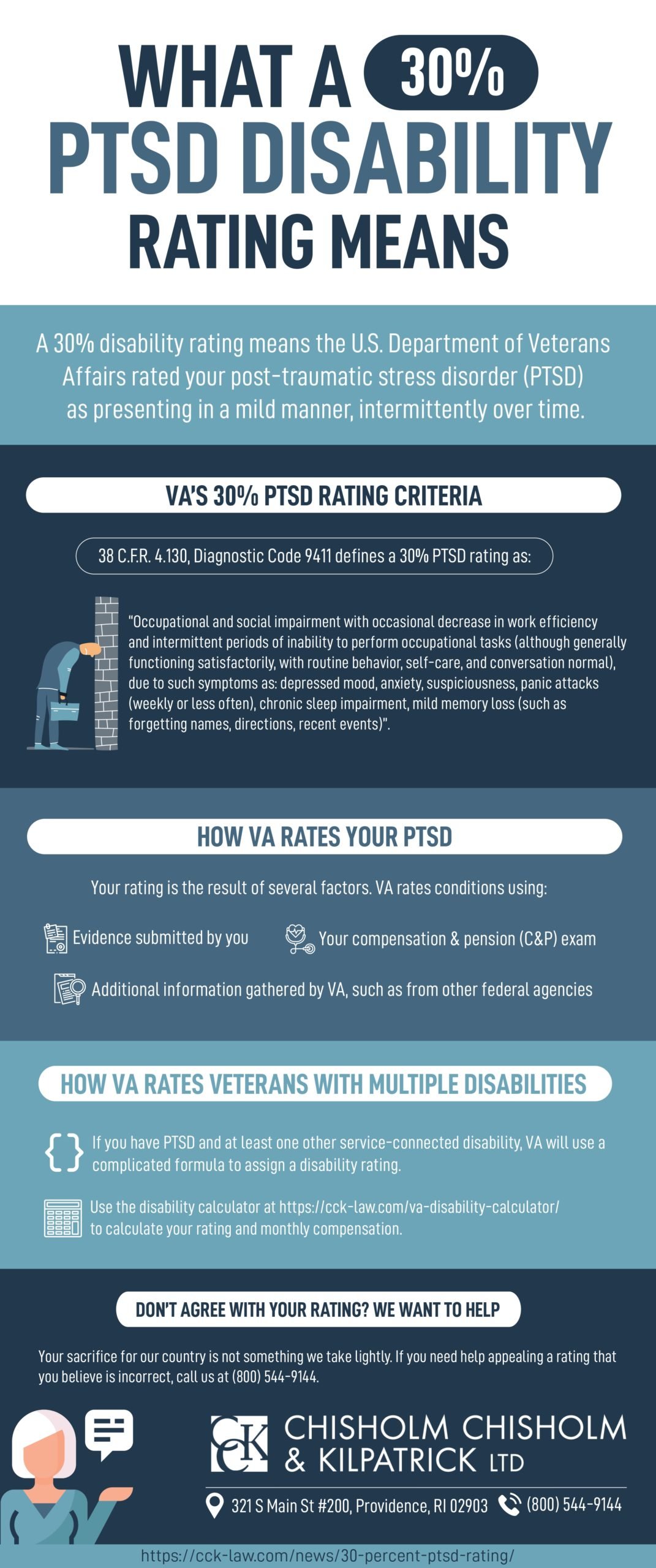30% PTSD Rating

Post-traumatic stress disorder (PTSD) is a mental health condition that can occur in people who have experienced or witnessed a distressing, shocking, or otherwise traumatic event. Unfortunately, many veterans experience PTSD stemming from their military service. The symptoms of PTSD can often be very debilitating and have a negative impact on an individual’s daily life.
How Does VA Rate PTSD?
Once you are service-connected for PTSD, VA will assign a disability rating. In doing so, VA will consider the frequency, duration, and severity of your symptoms along with the resulting level of social and occupational impairment. In other words, your disability rating reflects how you are affected in both your personal life and your work life. Generally, the more severe your symptoms are, the higher your disability rating will be. To determine your disability rating for PTSD, VA uses the General Rating Formula for Mental Disorders. This rating scale ranges from 0 percent to 100 percent with in-between ratings of 10, 30, 50, and 70 percent.
How Do I Receive a 30% Rating?
Each rating under the General Rating Formula for Mental Disorders has specific criteria that a veteran must meet in order to receive that evaluation. Here, the criteria are based on a number of symptoms as well as the varying severity of those symptoms. The criterion for a 30% PTSD rating under 38 C.F.R. 4.130, Diagnostic Code 9411, is as follows:
- 30% – “Occupational and social impairment with occasional decrease in work efficiency and intermittent periods of inability to perform occupational tasks (although generally functioning satisfactorily, with routine behavior, self-care, and conversation normal), due to such symptoms as: depressed mood, anxiety, suspiciousness, panic attacks (weekly or less often), chronic sleep impairment, mild memory loss (such as forgetting names, directions, recent events)”.
What Does the 30% Rating Criteria Mean?
The criteria for a 30% PTSD rating outlined above are meant to represent mild PTSD symptomology. In this case, “occasional decrease in work efficiency and intermittent periods of inability to perform occupational tasks” might mean that you are starting to periodically miss work due to your lack of motivation associated with PTSD. However, your PTSD does not fully prevent you from performing and succeeding in a work environment. Furthermore, you may experience symptoms such as depressed mood, anxiety, and panic attacks. This may cause you to occasionally isolate yourself. Nonetheless, you are still able to maintain your relationships with others. Overall, a 30% PTSD rating is assigned when a veteran demonstrates these symptoms presented in a mild manner, intermittently over time. However, it is important to note that a veteran does not need to endorse all of these symptoms to qualify for this rating. Even if a veteran only has a few of the specific PTSD symptoms listed, he or she can still receive a 30% rating.
Do you believe your PTSD rating should be higher?
If you believe that your VA PTSD rating should be higher than what VA has awarded, it is your right to appeal that decision. We may be able to help you. The skilled attorneys at Chisholm Chisholm & Kilpatrick work tirelessly in pursuit of our clients’ VA disability benefits. Contact our office today for a free consultation at (800) 544-9144.

About the Author
Share this Post
